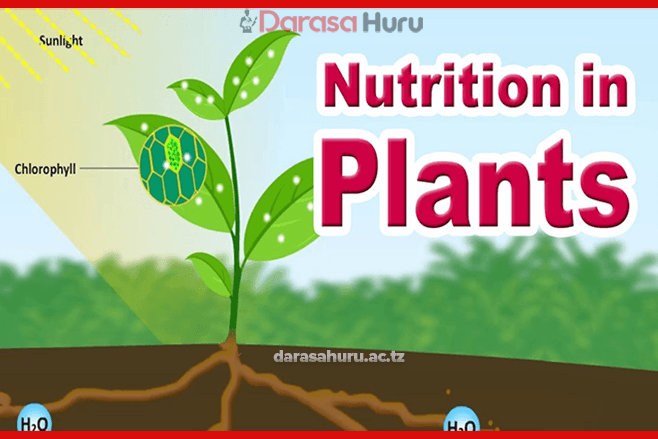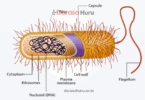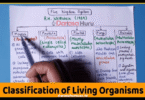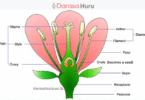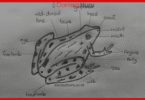Topic 6: Nutrition in Plants – Biology Form One Notes New Syllabus
Plants are organisms that can manufacture their own food, and therefore are called autotrophs. Other organisms that can manufacture their own food include some bacteria and protoctists.
Although plants can make their own food, they require some chemical elements from the environment. Such chemical elements are important for normal growth and development.
In this lesson, you will learn about photosynthesis process and its importance, as well as the structure of a leaf in relation to photosynthesis. You will also learn roles of essential mineral elements to plants. The competencies developed will enable you to explore the importance of plant nutrition to life.
Concept of nutrition
Nutrition is the process of feeding and utilising of food for energy provision, growth, development, repair and maintenance of the overall body health. Nutrition also refers to the study of the relationship between diet, health, and diseases.
There are two major types of nutrition based on how organisms obtain their food. These are autotrophic nutrition and heterotrophic nutrition. In this chapter, you will learn about autotrophic nutrition.
Autotrophic nutrition
Autotrophic nutrition is a type of nutrition in which organisms manufacture their own food using available energy sources. An organism that manufactures its own food is called an autotroph. The term ‘autotroph’ originates from two Greek words ‘autos’ which means ‘self’ and ‘trophy’ which means ‘feed’; hence ‘autotrophy’ means ‘self-feeding’.
This means that autotrophs are organisms that are capable of making their own food for their own use and for other organisms. Examples of autotrophic organisms include green plants, algae, and some bacteria such as cyanobacteria. The autotrophs can be divided into two groups based on how they obtain their energy. These are chemoautotrophs and photoautotrophs.
Chemoautotrophs are organisms that obtain their energy from chemical substances like hydrogen sulphide, iron, methane, and ammonia. They utilise these chemicals to make their own food in the form of carbohydrates through a process called chemosynthesis.
Examples of chemoautotrophs are some bacteria (archaebacteria) that live in harsh environments. Such environments include the deep sea and around volcanic sites where there is no sunlight and where many other organisms cannot survive.
Photoautotrophs are organisms that obtain their energy from sunlight in order to make their own food. They make their food using water and carbon dioxide in the presence of chlorophyll and sunlight through a process called photosynthesis.

Photosynthesis
Task 1
Search from the library and reliable internet sources the information on the meaning of photosynthesis.
Photosynthesis is the process by which green plants, some bacteria and protoctists make their own food using water and carbon dioxide in the presence of sunlight energy. Organisms that make their own food are called primary producers or autotrophs.
They are the primary source of food for all other organisms. During the process of photosynthesis, six molecules of carbon dioxide and twelve molecules of water combine to form one molecule of glucose (a simple sugar), six molecules of water, and six molecules of oxygen.
The leaf is the main site for photosynthesis in plants. However, photosynthesis can take place in other green parts of the plant, such as stem. The following chemical equation represents the photosynthesis process in plants.

Photosynthesis produces a six-carbon sugar molecule (a hexose) called glucose. Plants convert these hexose sugars into other carbohydrates, such as complex sugars, starch and cellulose. Plants are also capable of converting hexose sugars into other organic compounds, such as proteins and fats. The food formed by plants during photosynthesis is stored in the form of starch.
Biologists often use the presence of starch in some parts of plants as an indication that photosynthesis has taken place.

Structure of the leaf in relation to photosynthesis
The internal and external structures of a leaf make it well adapted for photosynthesis. In most plants, the leaf is the main site for photosynthesis, although some plants, such as cactus (plural is cacti) use their stems for photosynthesis. The leaf structure provides a very efficient means for absorbing carbon dioxide and sunlight.
External structure of a leaf
The external features of a leaf can be viewed using either a hand lens or with the naked eye. Figure 6.1 shows the external structure of a leaf.

The petiole or leaf stalk attaches the leaf to the branch or stem. It keeps the lamina in a position that will enable it to get maximum amount of sunlight. The lamina or leaf blade is the expanded portion of a leaf. It has a large surface area. This maximizes the absorption of sunlight energy and carbon dioxide.
The lamina is also thin so that carbon dioxide gas can diffuse and sunlight energy can penetrate over a short distance to reach cells. The mid-rib and veins contain vascular tissues, namely xylem and phloem. Xylem transports water and dissolved minerals while phloem transports manufactured food in the plants.
Activity 1
Observing the external features of a leaf
Materials
Leaves from various plants, hand lens, pen or pencil, notebook and rubber
Caution
Be careful not to collect hairy or thorny leaves.
Procedure
1. Collect different plant leaves from the school or home environment.
2. Observe each of the leaves using your naked eyes.
3. Observe each of the leaf using the hand lens. Note as many details as you can.
4. Describe each of the observed leaves.
5. Explain how each of the plant parts aids photosynthesis.
Question
State the observed differences in structure among the variety of leaves.

Internal structure of a leaf
Task 6.2
Search from library and reliable internet sources the information on internal structures of a leaf that are related to photosynthesis.
The internal features of a leaf can be viewed under a microscope. Figure 6.2 shows the internal structure of a leaf. The leaf has lower and upper parts which are covered by a thin waxy layer called cuticle. On the upper part of the leaf is the upper epidermis while the lower epidermis is located on the lower part of the leaf.
The leaf has small openings called stomata. Depending on the species of a plant and the environment in which it grows, the leaf can either have stomata on both sides on one side (lower or upper part). But in most plants, the lower epidermis has more stomata than the upper epidermis. Immediately below the epidermis is another tissue layer called mesophyll, that is photosynthetic because it contains chloroplasts.
The mesophyll tissue is divided into two parts, namely the palisade and spongy mesophyll. The palisade mesophyll cells are usually tightly packed. The spongy mesophyll has loosely packed cells. It also consists of air spaces and vascular tissues which are made up of xylem and phloem cells, as shown in Figure below

The cuticle
This is the outermost transparent and waxy layer of the leaf. It allows light to penetrate into the photosynthetic cells. It also protects the leaf from injury, pests, and excessive loss of moisture. In order to allow gaseous exchange, there is no cuticle on the stomata.
The epidermis
This is the outermost layer of cells found on both lower and upper surfaces of a leaf. It is transparent and only one cell is thick, hence it allows sunlight to penetrate the leaf easily. The epidermis has pores called stomata.
Stomata
Stomata (singular is stoma) are small pores in the epidermis. They allow oxygen and carbon dioxide to diffuse in and out of the leaf. Stomata are surrounded by guard cells that close and open the pores.
Mesophyll
This is made up of palisade layer and spongy layer (See Figure 6.2). The palisade mesophyll is made up of cells that are elongated and arranged at right angles to the surface of the leaf. It is found just below the upper epidermis. Being near the upper epidermis, the palisade cells are exposed to maximum sunlight. This enables the cells to absorb maximum amount of sunlight energy.
The spongy mesophyll is just above the lower epidermis. It is a loosely constructed layer of irregularly shaped cells separated by large intercellular air spaces that connect with each other and linked to the atmosphere through the stomata pores. The air spaces in the spongy mesophyll provide an immediate source of carbon dioxide.
Activity 2
Investigating the internal structure of a leaf
Materials
Prepared slide of a transverse section of a leaf, microscope, notebook, and pencil or pen
Procedure
1. Mount the prepared slide on the microscope.
2. Observe the slide under the low power objective lens. What do you see?
3. Describe what you have observed.

The process of photosynthesis
Task 3
Search from reliable internet sources the simulations that show the process of photosynthesis. Note down what you have observed.
Photosynthesis takes place in cell organelles known as chloroplasts. These are mostly found in the green leaves. Chloroplasts contain chlorophyll that is responsible for trapping sunlight energy that is used during photosynthesis. Photosynthesis takes place in two stages, namely light reaction and dark reaction.
The light reaction or light dependent reaction stage
This stage takes place in specialised structures of the chloroplast called grana. The grana (singular is granum) contain chlorophyll that absorbs light energy from the sun.
The light dependent reaction changes light energy into chemical energy. The formed energy is stored in a chemical compound called ATP (Adenosine Triphosphate). This energy is used in the dark reaction stage of photosynthesis.
Light energy causes photolysis, a chemical process whereby water molecules (H2O) are split into hydrogen ions (H+) and hydroxyl ions (OH–). This can be represented using the following equation.

The hydroxyl ions undergo further reactions to produce water and oxygen. Some oxygen is released into the atmosphere. The rest of the oxygen is used for respiration in the plant. Hydrogen ions are used in the dark reaction stage to synthesise food together with carbon dioxide from the air.
The dark reaction or light independent reaction stage
This stage takes place in the stroma in the absence of light. The stroma is a colourless matrix of fine material found in the chloroplast. During the dark reaction stage, hydrogen ions from light reaction stage and carbon dioxide from the atmosphere combine to form glucose that is the simplest carbohydrate.
Glucose is later converted into starch. Starch is insoluble and acts as a temporary storage of excess carbohydrates. It can easily be converted into glucose when a plant needs energy. Glucose may also be converted into cellulose (the structural material of plants). Lipids and proteins are also formed from glucose through complex processes.
Activity 3
An experiment to determine the presence of starch in a leaf
Materials
A leaf, absolute ethanol, iodine solution, source of heat, test tube, beaker, dropper, forceps, water, white tile, cotton wool, notebook, and pencil
Procedure
1. Take a leaf from a plant that has been in the sunlight for at least 6 hours.
2. Put the leaf in boiling water for 2-3 minutes, as shown in Figure 6.3. This stops further chemical reactions in the leaf because boiling kills the leaf cells.

3. Put the boiled leaf in the test tube containing absolute ethanol. Cover the test tube with cotton wool. Place the test tube in a beaker of boiling water, as shown in Figure 6.4. The absolute ethanol dissolves the chlorophyll.
Caution
Do not heat absolute ethanol directly because it is highly flammable. Cover the test tube with cotton wool.

4. Remove the leaf from the absolute ethanol and rinse it in warm water. The water softens the leaf.
5. Put the leaf on a white tile. Add 2-3 drops of iodine solution on the leaf. What do you observe?
6. Record your observations.
Note: The blue-black colour indicates the presence of starch.

Activity 4
An experiment to determine the importance of carbon dioxide in photosynthesis
Materials
Conical flasks, thread, corks, soda lime, water, iodine solution, dropper, potted plant, notebook, absolute ethanol, white tile, test tube, source of heat, beaker, pen or pencil
Procedure
1. Place the potted plant in dark place for at least 24 hours to destarch its leaves.
2. Enclose a leaf (A) in a conical flask containing soda lime, as shown in Figure below. This leaf will not have a supply of carbon dioxide from the air because soda lime absorbs carbon dioxide.
3. Enclose a second leaf (B) in a conical flask containing some water.

Experimental set-up to determine the importance of carbon dioxide in photosynthesis
4. Place the plant in sufficient light for 6 hours at room temperature.
5. Remove the two leaves (leaf A and B) from flasks.
6. Test for starch by using standard procedures as in Activity 6.3.
7. Record your observations.

Activity 5
An experiment to determine whether chlorophyll is necessary for photosynthesis
Materials
Variegated leaves, iodine solution, absolute ethanol or spirit, beaker, white tile, water, heat source, pencil, and notebook
Procedure
1. Pick a variegated leaf from a plant that has been exposed to sunlight for at least 6 hours. Variegated leaves are green but mixed with patches of other colours, such as yellow, red and white. The green areas have chlorophyll but areas with other colours do not have chlorophyll. Figure 6.6 shows variegated leaves with green and yellow patches.

2. Describe a colour map of the leaf.
3. Test the leaf for the presence of starch using standard procedures as in Activity 6.3.
4. Compare the stain patterns with the described colour map. What do you notice?
5. Record your observations and then share with your teacher.
Question
Based on the results you have obtained, what conclusion can you draw about variegated leaves in relation to photosynthesis?

Activity 6
An experiment to determine whether sunlight is necessary for photosynthesis
Materials
Potted plant, manila card, paper clips, absolute ethanol or methylated spirit, iodine solution, test tube, beaker, water, white tile, notebook, and pen or pencil
Procedure
1. Place the potted plant in a dark place for 24 hours to destarch its leaves.
2. Use manila card (opaque paper) and paper clips to cover the upper and lower epidermis of one leaf as shown in Figure below

3. Put the plant in bright sunlight for 6 hours.
4. Detach the leaf that has been covered by manila card from the plant.
5. Remove the paper clips and manila card.
6. Test the detached leaf for starch using the standard procedure. What do you notice?
7. Discuss your observations with your classmate.
General conclusion
The above experiments have shown that chlorophyll, water, carbon dioxide, and sunlight are necessary for photosynthesis. The process of photosynthesis cannot take place in the absence of any of these. If sunlight or carbon dioxide are in low supply, the rate of photosynthesis will decrease. In addition, magnesium and iron elements are essential for the production of chlorophyll. If they are in low supply, the rate of photosynthesis decreases because chlorophyll pigment is insufficient.

Activity 7
An experiment to verify that photosynthesis produces oxygen
Materials
Test tube, beaker, sodium hydrogen carbonate, filter funnel, pond weed, wooden splint, a lighter, notebook, and pen or pencil
Procedure
1. Put the pond weed in a beaker containing water. Put one spatula of sodium hydrogen carbonate in the water. This serves as a source of carbon dioxide.
2. Put a plant under a funnel and collect the bubbles in an inverted test tube, as shown in Figure below

3. Leave the set-up exposed to the sunlight for 6 hours.
4. Remove the test tube slowly, covering its mouth while it is still under water.
5. Open the test tube slightly but quickly and introduce a glowing splint.
6. Record what you have observed.
Questions
1. What did you observe when the experimental set-up was exposed to sunlight?
2. What did you observe when a glowing splint was introduced into the test tube?
3. Why did gas bubbles evolve from the bottom part of the experimental set-up?
4. Name the gas that evolved from the experimental set-up and give reason to support your answer.
5. What conclusion can you draw from this experiment?

Importance of photosynthesis
Task 4
Read from reliable internet sources and biology books information about the importance of photosynthesis
Photosynthesis is a vital process for the continuous survival of plants and other organisms on earth. The importance of photosynthesis includes production of oxygen, reduction of atmospheric carbon dioxide, conversion of solar energy into chemical energy, and production of food.
Production of oxygen
Photosynthesis produces oxygen. This replenishes the atmospheric oxygen that has been used during burning, respiration, rusting, and other processes. All aerobic organisms require oxygen for respiration.
Reduction of atmospheric carbon dioxide
The process of photosynthesis uses carbon dioxide from the atmosphere. This process reduces atmospheric carbon dioxide, since it is converted into carbohydrate in the presence of water, sunlight, and chlorophyll. Being a by-product of respiration, carbon dioxide is harmful if excessive amounts accumulate in the atmosphere. The accumulated carbon dioxide forms a layer, which traps heat escaping from the earth’s surface and re-radiates it back to the earth’s surface, thus causing global warming.
Conversion of solar energy into chemical energy
Photosynthesis converts sunlight energy into chemical energy. The sun is the primary source of all forms of energy used in life processes. This energy is used by plants as well as animals. It is made available to living things through photosynthesis. Animals obtain energy by feeding on plants or animals that eat plants. Thus, sunlight energy is converted into chemical energy that is stored in organic food molecules. The energy stored in organic food molecules is then released into the cells during respiration. This energy is used in life processes, such as movement, reproduction, sensitivity, growth, and excretion.
Production of food
Photosynthesis produces food for the plants. Some animals, such as cattle, goats, and zebra depend directly on plants as their source of food. Such animals are called herbivores. Other animals called carnivores, such as lions, hyenas, and leopards feed directly on herbivores by killing and eating them. Animals, such as human beings and monkeys depend on both plants and animals as their source of food. These are called omnivores.
The extra food produced by plants is stored in various plant organs. The stored food is used by the plants during adverse conditions, such as drought when the plant cannot synthesise adequate amounts of food. The underground storage organs of the plants are formed from modified stems, leaves or roots. There are several types of underground storage organs, such as bulbs, tubers, roots, corms, and rhizomes.
Bulb: This is an underground storage organ formed from the modification of the plant stem and leaves. An onion is an example of a bulb, as shown in Figure below

Tuber: This is a fleshy storage organ formed from either a stem or a root. An examples of a stem tuber is Irish potato while an example of a the root tuber is sweet potato.


Taproot: Some taproots such as those of carrot, sugar beet, and beetroot are specialised for food storage (See Figures).



Corm: This is an underground storage organ formed from the plant stem. It is a mass of solid tissues with a dry papery cover made of modified leaves. Examples of corms are yams, cocoyams and crocuses (See Figure).


Rhizome: A rhizome is a swollen underground stem, which grows horizontally on the surface or just below the surface. An example is ginger, as shown in Figure below.

Exercise 1
1. Explain the importance of chloroplasts in plants.
2. Describe the internal structure of a leaf.
3. What are the roles of underground storage organs in plants?
4. Why are vascular bundles important in plants?
5. Explain why it is not advisable to sleep in a room with a potted plant.
Essential and non-essential elements in plants
Task 5
From reliable sources read the information about the essential and non-essential elements in plants.
There are many chemical elements which are known to be important for plant growth and development. These chemical elements are divided into two major groups, namely essential and non-essential elements. The essential elements are vital for plant development and survival.
The plant cannot complete its life cycle without them. These include Nickel (Ni), carbon (C), hydrogen (H), oxygen (O), nitrogen (N), phosphorus (P), calcium (Ca), iron (Fe), manganese (Mn), potassium (K), magnesium (Mg), sulphur (S), boron (B), copper (Cu), zinc (Zn), molybdenum (Mo), and chlorine (Cl). The non-essential elements are used to stimulate growth in plants. Examples of non-essential elements include lithium (Li), iodine (I), sodium (Na), mercury (Hg), silver (Ag), tin (Sn), radium (Ra), silicon (Si), bromine (Br), and cobalt (Co).
The essential elements can also be divided into two groups, which are macroelements and microelements. The macroelements are those elements that are required by plants in relatively large amounts.
They are also known as macronutrients. These include phosphorus (P), potassium (K), nitrogen (N), sulphur (S), magnesium (Mg), calcium (Ca), carbon (C), oxygen (O), and hydrogen (H).
Among the macroelements, some are non-minerals, such as carbon, oxygen and hydrogen, that are obtained from the air. Other macroelements are minerals, such as magnesium, calcium, phosphorus and potassium.
Both non-mineral and mineral elements are essential for normal plant growth and metabolic activities. For example, carbon is a major constituent of plants, hydrogen is required during photosynthesis and oxygen is required during respiration. The essential mineral elements are mainly absorbed by plants from soil. They usually dissolve in water and are absorbed by plants in form of ions.

The ions enter the plant through roots and are transported upward through the vascular system. Table 6.1 shows various sources of macroelements in plants.
Sources of different macroelements in plants
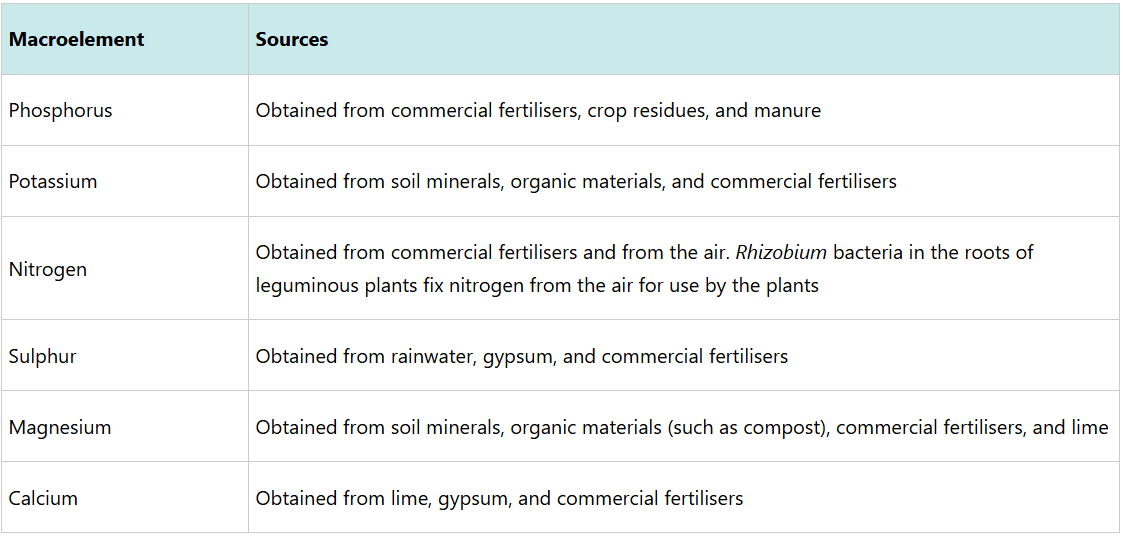
Functions of macroelements in plants
Task 6
Read from reliable online sources and books about the functions of macro and microelements in plants
Each mineral element has a specific function in the plant body. Some are used in the formation of building materials for proteins and carbohydrates in plants while others play important roles in other metabolic activities of the plant. The deficiency of such elements will eventually affect plant growth and metabolic activities. Table 6.2 shows the functions, signs of deficiency, and effects of excess macroelements in plants.
Functions, signs of deficiency, and effects of excess macroelements in plants
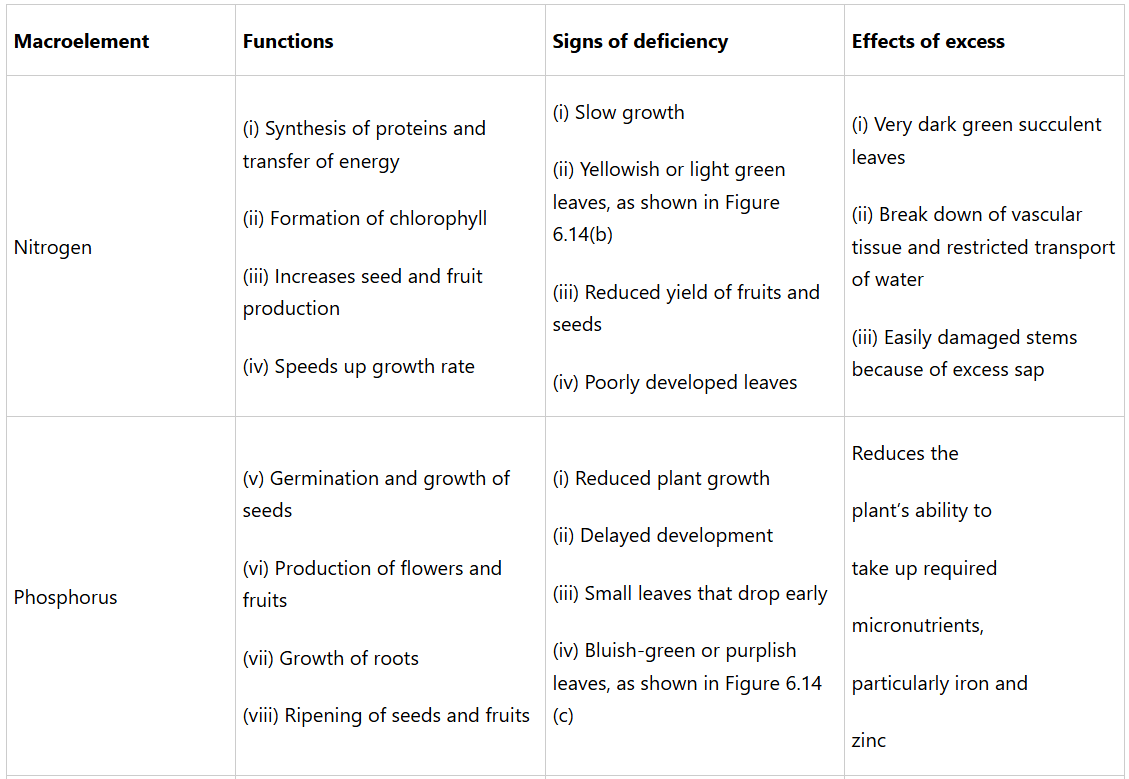
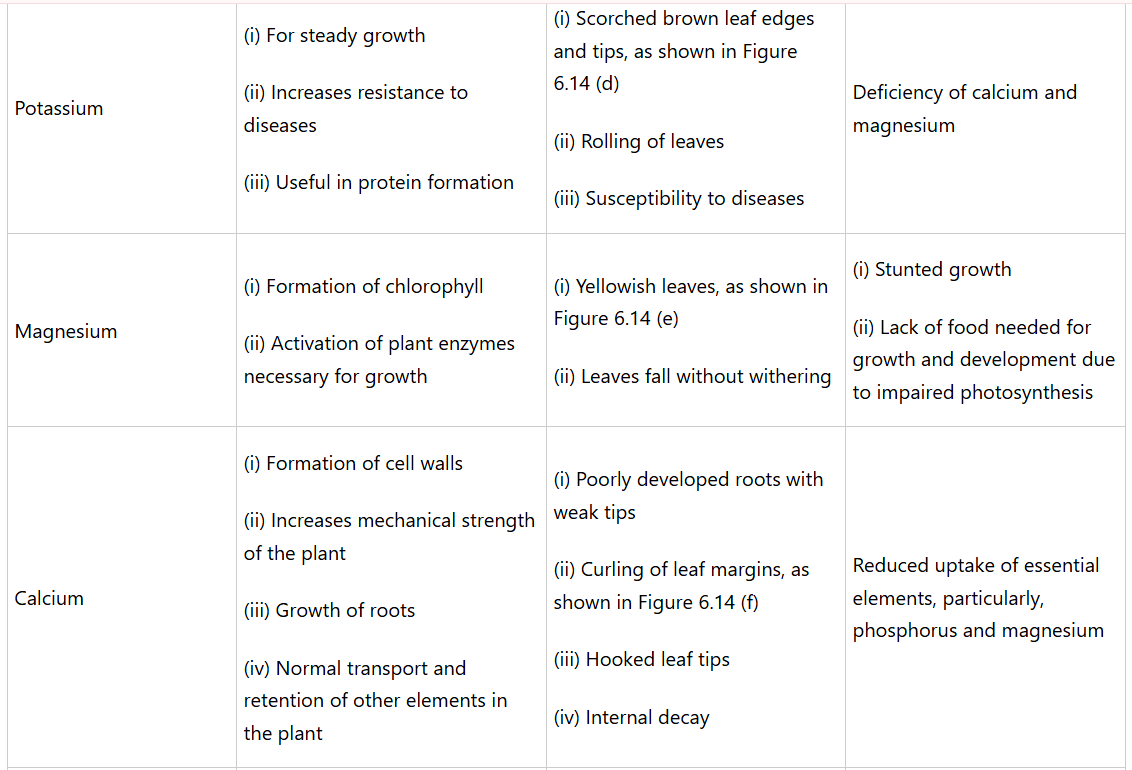


Microelements are essential mineral elements that are needed for plant growth and survival but only in very small quantities. However, deficiency or excess of microelements in plants can have effects on physiological activities of plants.
These elements are also referred to as trace elements. They include boron, copper, iron, chlorine, manganese, zinc, nickel, and molybdenum. Table 6.3 shows functions of microelements in plants, deficiency signs, and effects of their excess levels.
Functions, deficiency signs, and effects of excess microelements in plants
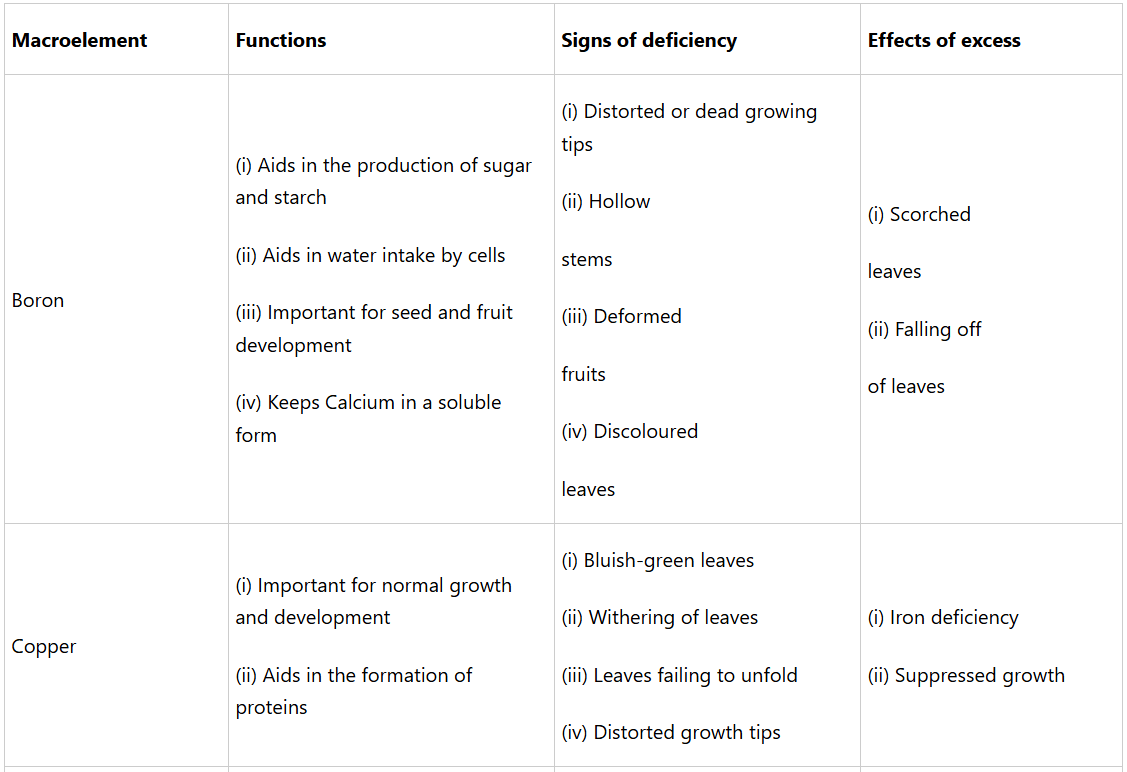
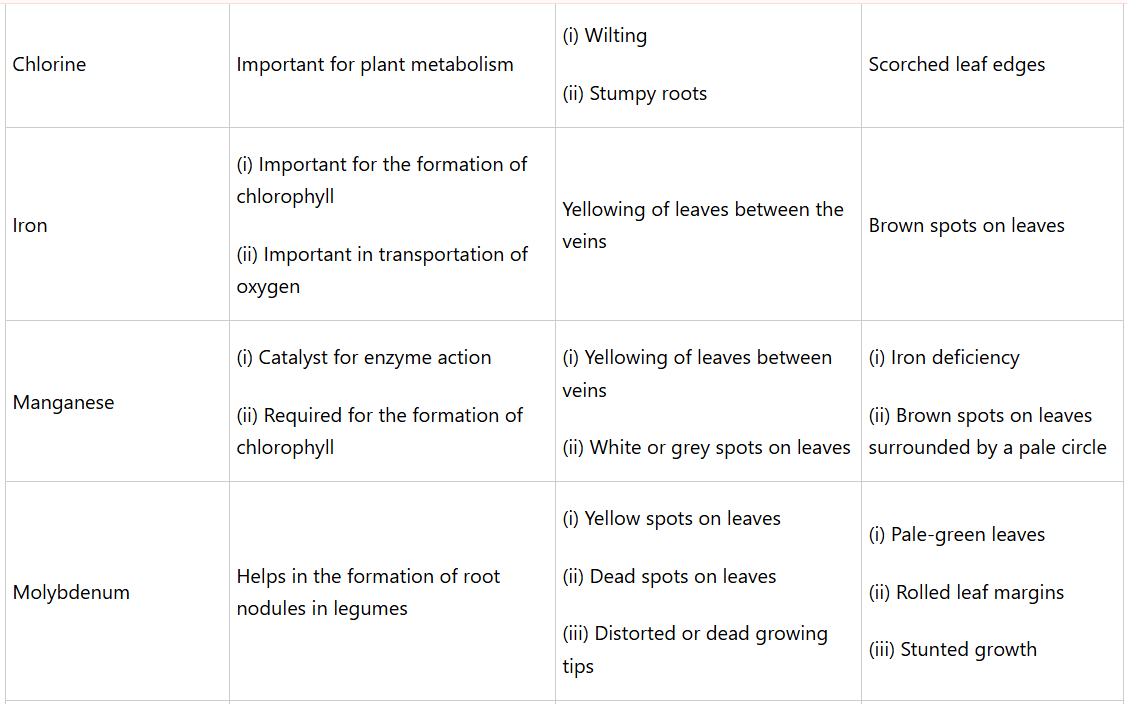

Activity 8
Investigating the effects of mineral elements on plant growth
Materials
Pots or tins, seeds (such as maize and beans), fertilisers containing different minerals, notebooks, and a pen
Procedure
1. Prepare pots or tins for planting seeds.
2. Plant the same types of seeds in all pots or tins.
3. Your teacher will explain what is in each type of fertiliser (for example, ‘NPK’ has Nitrogen, Phosphorus and Potassium) and the proper amounts of each type of fertiliser required by the plants.
4. Vary the amounts of fertiliser that you apply in the pots or tins as follows:
(a) Do not put any fertiliser in the first pot or tin.
(b) Put adequate amounts of fertiliser in the second pot or tin.
(c) Put excess amounts of fertiliser in the third pot or tin.
5. Water all experimental pots or tins every morning and evening with the same amount of water for a period of 30 days.
6. Make daily observations of the plants in the pots or tins, including height and leaves colouration. Record the observations.
Questions
1. Is there any difference in growth of the plants in the three pots or tins? Give reasons.
2. Why was the fertiliser not applied in the first pot or tin?
Exercise 2
1. As a Biology student, you are investigating the role of elements in plant growth. Explain the fundamental difference between essential and non-essential elements in the environment of plant nutrition.
2. You are working on a research project focusing on the importance of individual elements in plant growth. Explain why phosphorus is considered crucial for plant growth and development.
3. You are leading a discussion on the differences between microelements and macroelements in your classroom. Explain the differences between these two categories of nutrients.
Chapter summary
1. Photosynthesis is the process by which green plants, some bacteria and some protoctists make their own food using carbon dioxide and water in the presence of sunlight.
2. A plant leaf comprises features that make it well adapted to photosynthesis.
(a) Waxy transparent cuticle
(b) Thin epidermis with stomata
(c) Palisade cells with chloroplasts
(d) Palisade cells positioned just below the upper epidermis
(e) Spongy mesophyll with air space
(f) Veins that have vascular tissue
(g) Broad flat lamina
(h) Petiole to attach the leaf to the stem or branch at an appropriate angle to access sunlight
3. Photosynthesis involves two stages, namely the light reaction stage and the dark reaction stage.
4. During the light reaction stage, sunlight causes the production of ATP and splitting of water molecules into hydrogen and hydroxyl ions. This reaction is called photolysis.
5. In the dark reaction stage, carbon dioxide and hydrogen ions combine to form glucose. This reaction is called carbon dioxide fixation. Glucose is later used to make starch, proteins and lipids.
6. Plants require both macroelements and microelements to survive.
7. The macroelements include nitrogen, phosphorus, potassium, sulphur, calcium, and magnesium.
8. The microelements include boron, copper, iron, chlorine, manganese, molybdenum, and zinc.
9. Lack of the necessary elements affects plant growth and crop yields. However, excessive amounts have negative effects. Plants should get optimum amount of minerals.
Revision Exercise
Section A
Choose the correct answer.
1. Which of the following is NOT a type of an underground storage organ?
(a) Bulb
(b) Seed
(c) Corm
(d) Rhizome
2. The process by which plants and some bacteria use the energy from sunlight to produce glucose is called _______.
(a) Photolysis
(b) Hydrolysis
(c) Photosynthesis
(d) Plasmolysis
3. Boron, copper, iron, chlorine, manganese, molybdenum and zinc are examples of:
(a) microelements
(b) macroelements
(c) non-mineral elements
(d) organic elements
4. The part of a leaf that provides a large surface area for maximum absorption of sunlight and carbon dioxide is:
(a) petiole
(b) stomata
(c) lamina
(d) midrib
5. Write TRUE for correct statements and FALSE for incorrect statements in the spaces provided.
(a) The leaf is the main site for photosynthesis in plants. _______
(b) Essential elements are necessary for plant growth, development, and reproduction. _______
(c) Carbon, oxygen, hydrogen, and nitrogen are non-minerals. _______
(d) Rhizobium bacteria helps to fix nitrogen from the air into the soil. _______
(e) Microelements are needed by plants in large quantities. _______
(f) Copper is an example of trace elements. _______
(g) Lamina is the external part of a leaf while midrib is the internal part. _______
(h) A bulb is an underground storage organ formed from the plant roots. _______
(i) Sunlight energy is not needed during photosynthesis. _______
(j) Unlike carnivores, autotrophs make their own food in the form of carbohydrates. _______
Section B
1. Briefly explain the following terms.
(a) Photosynthesis
(b) Palisade mesophyll
(c) Photolysis
2. Differentiate the light reaction stage from dark reaction stage of photosynthesis.
3. Describe how a plant leaf is adapted to photosynthesis.
4. Why is photosynthesis a vital process for all living organisms?
5. Why is it necessary to destarch a leaf in an experiment investigating the importance of photosynthesis to plants?
6. Answer the following questions.
(a) Mention any two sources of sulphur in plants.
(b) Give any two signs of sulphur deficiency in plants.
(c) List down at least three functions of sulphur in plants.
(d) Why should a leaf be boiled in alcohol when testing for starch?
(e) List down the necessary conditions for photosynthesis.
7. Study the two plant leaves in Figure 6.15 and then answer questions (a) and (b).

(a) For each of the signs shown in figures 6.15 (a) and (b), name the macroelement that is in limited supply.
(b) Outline the effects of excessive amounts of the macroelement stated (a) above.
8. An agricultural officer advised farmers to apply fertiliser that contains nitrogen, phosphorous and potassium in their farms with mineral deficiency. Which signs were shown by plants that made the agricultural officer give such advice to farmers?

